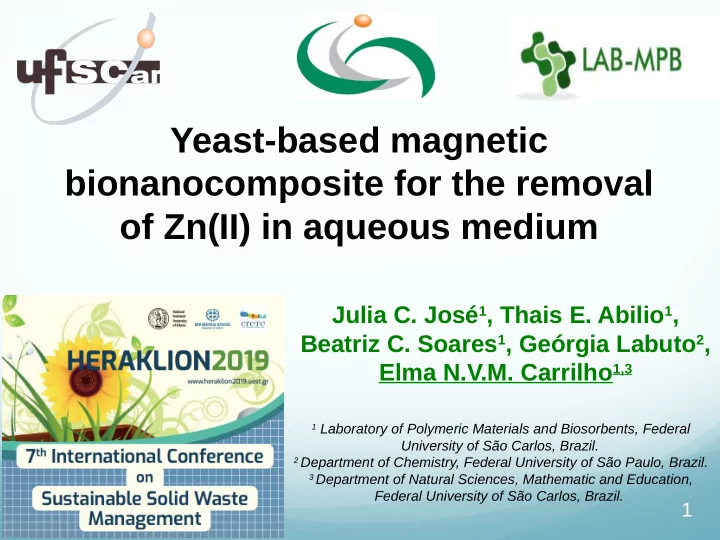

Yeast-based magnetic bionanocomposite for the removal of Zn(II) in aqueous medium Julia C. José 1 , Thais E. Abilio 1 , Beatriz C. Soares 1 , Geórgia Labuto 2 , Elma N.V.M. Carrilho 1,3 1 Laboratory of Polymeric Materials and Biosorbents, Federal University of São Carlos, Brazil. 2 Department of Chemistry, Federal University of São Paulo, Brazil. 3 Department of Natural Sciences, Mathematic and Education, Federal University of São Carlos, Brazil. 1
An important field!!! 2
Biosorption by yeast-based material 3
4
The quality of water resources impact caused by human activities 5
Biosorption Adsorption using biological waste – Biomass Advantages Advantages Favorable Renewable Favorable Renewable economic value resources economic value resources High capacity for the High capacity for the removal of contaminants removal of contaminants 6
Yeast biomass Rich in sorption sites (carboxylic, phosphates, hydroxyls groups) for accumulation of contaminants; 30 g for each 900,000 ton/year!!! L of alcohol Widely used in fermentative process. 7 Source: Brazil, MAPA, 2017.
Ferromagnetic Nanoparticles (Fe 3 O 4 ) Superparamagnetics properties: • Smaller size; • Greater interaction; • Magnetized particles throughout the struture with the same intensity. It can improve the adsorption capacity of biomass (hydroxyls groups); It facilitates the removal from the medium. 8
Goals This work proposes to: synthesize, characterize, and evaluate a nanomodified yeast biosorbent for the sorption of Zn(II) in aqueous environments; to compare in natura biomass and synthesized magnetite composite to investigate the effect of magnetization in the efficiency of sorption. 9
Synthesis of ferromagnetic nanoparticles (coprecipitation method) 30 min Fe 2+(aq) + 2 Fe 3+(aq) + 8 OH -(aq) Fe 3 O 4(s) + 4H 2 O (l) Impregnation of nanoparticles to yeast biomass 30 min; 80 °C Fe 3 O 4(s) + YB (s) YB-Fe 3 O 4(s) Yeast biomass Fe 3 O 4 Composite (YB) (MNP) (YB-MNP) 10
Characterization of adsorbents X-Ray Diffraction (XRD) Identification of crystalline structures of the materials; Scanning Electron Microscopy (SEM) It is possible to obtain external images showing the surface of the materials; Fourier Transform Infrared Spectroscopy (FTIR) Detects the absorption in a characteristic region, identifying the functional groups in the materials. 11
X-Ray Diffraction (XRD) YB – yeast biomass MNP – magnetic nanoparticles YB-MNP – magnetic composite YB amorphous Peaks attributed to characteristic magnetite planes MNP YB-MNP 12
Scanning Electron Microscopy (SEM) YB YB – yeast biomass MNP – magnetic nanoparticles YB-MNP – magnetic composite YB-MNP MNP 13 Source: Debs et al., 2019.
Fourier Transform Infrared Spectroscopy (FTIR) N-O Fe-O C=O N-H and O-H 14
Point of zero charge (pH PZC ) 10 mg of YB or YB-MNP + 10 mL of NaCl 0.1 mol/L Stirring at 185 rpm for 24 h 5 7 8 9 10 11 12 3 6 pH 2 4 Initial pH vs final pH 15
Point of zero charge (pH PZC ) Negative charges on the surface of the biosorbent (above pH PCZ ) Favors the adsorption of Zn(II) Best adsorption is expected at pH higher than pH PCZ . 16
pH assessment 500 mg of YB or YB-MNP Stirring at 185 rpm for 10 mL of 100 mg/L Zn(II) 10 min pH 5.5 6.0 6.5 Zn determination by Flame Atomic Absorption Spectrometry YB-MNP YB Nd magnet 17
pH assessment 18
Kinetics studies centrifugation 200 mg of YB or YB-MNP 10 mL of 100 mg/L Zn(II) YB Stirring at 185 rpm at pH 6.0 Nd magnet YB- MNP 60 150 30 90 120 10 t, min 5 Zn determination by FAAS 19
Kinetic studies 20
Kinect studies Qe Q exp YB = 4.26 YB-MNP = 4.70 Chemical nature!!! 21
Sorption capacity tests centrifugation 10 mL of Zn(II) solutions 200 mg of YB, MNP or YB-MNP Stirring at 185 rpm; pH 6.0; 5 and 30 min YB Nd magnet YB- 175 200 100 MNP 75 125 150 mg Zn/L 25 50 Zn determination by FAAS 22
Non-linear isotherm models employed to fit Zn(II) adsorption by YB, MNP, and YB-MNP. Foo and Hammed, 2010; Saadi et al., 2015; Ayawei et al., 2017. 23
24
25
Conclusions With characterization, it was possible to infer that, in fact, the impregnation of the nanoparticles to the yeast biomass occurred; The model that best fit the experimental data was Sips, considering that chemical and physical phenomena contribute to the sorption process; The magnetite, besides facilitating the removal of the biosorbent from the medium, increases the sorption capacity; Thus, it is perceived that the synthesized material is environmentally advantageous and functions as a good biosorbent for removal of Zn(II) in aqueous medium. 26
The biosorption group 27
ΕΥΧΑΡΙΣΤΩ Thank you Obrigada 28
Recommend
More recommend